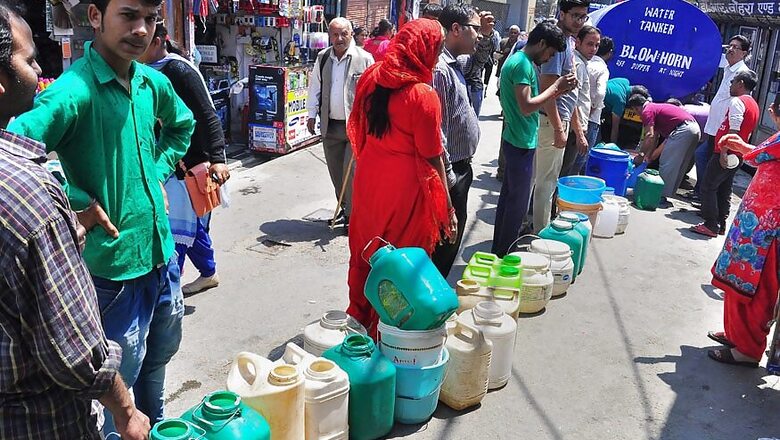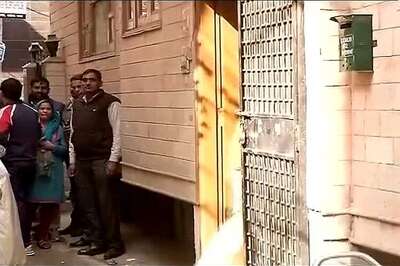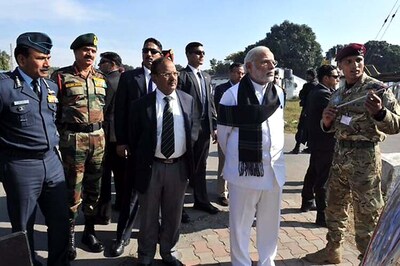
views
New Delhi: In view of the water crisis in country, the Centre has decided to set aside 75% of the work under Mahatma Gandhi National Rural Employment Guarantee Scheme (MGNREGS), the rural employment guarantee scheme, to conserve water. On June 30, News18 published a report on how states have failed to utilise MGNREGS to fix the water shortage menace in the country despite NITI Aayog calling out states on their underperformance.
As per the Niti Aayog report, released in June 2018, the watershed programmes create lakhs of jobs and contribute to about 80% of all MGNREGS work (including for soil conservation), which also becomes significant, considering the rate of unemployment in the country.
However, that has not been the case in reality, as per the MGNREGS data. The total contribution of water-related work in the country has been decreasing since 2014-15, coupled with the decrease in percentage share of expenditure on these works. As per the News18 analysis, the water related work in the country has been ranging from 20.16% during 2014-15 to 11.16% during 2019-20 of all the work. Year 2018-19 has seen the least amount of water-related work through MGNREGS with 10.07% of all work.
Except for Dadra and Nagar Haveli, Puducherry and Goa, the average water-related works carried out by each state since 2014-15 is not even 50% of all the works.
The Niti Aayog report stated that 600 million people in India face high to extreme water stress. About three-fourths of the households in the country do not have drinking water facility in their premises. With nearly 70% of water being contaminated, India stands at 120th spot in the water quality index of 122 countries. In the Composite Water Management Index report, the government think-tank categorised the states in three categories — high, medium and low — based on their respective performances in managing the water resources.
Apart from Gujarat, Andhra Pradesh and Madhya Pradesh, all the other states were either medium or low performers. Some states were not classified due to unavailability of data. Seven states including Tamil Nadu, where Chennai is undergoing serious water crisis, were categorized into medium performers. 60% of the analysed states were in the “low” category for being “alarmingly” poor towards conserving water. In the descending order, the 14 low performers were Chhattisgarh, Sikkim, Rajasthan, Goa, Kerala, Odisha, Bihar, Uttar Pradesh, Haryana, Jharkhand, Assam, Nagaland, Uttarakhand and Meghalaya. Most of these states are concentrated across the populous agricultural belts of north and eastern India, and among the North-Eastern and Himalayan states. As per the report, three of the Northeastern and Himalayan states, Assam, Himachal Pradesh and Uttarakhand, and six of the non-Himalayan states, Goa, UP, Kerala, Maharashtra, Tamil Nadu and Odisha have only worsened since 2015-16.
The categorisation considered several factors of water management such as restoration of water bodies like rivers, ponds and tanks, augmentation of water sources such as groundwater recharging and boosting irrigation potential. Many of these parameters match the water-related work carried out under the MGNREGS. The NITI Ayog report has called out the states for their underperformance. Yet, the state governments have failed to utilise the livelihood security programme to improve the water menace in their respective states. There has been a decline in the quantity of water-related works carried out under the MGNREGS by several states, including the high performers – Andhra Pradesh and Madhya Pradesh.
The major decline is in the irrigation projects followed by groundwater recharge works from 2016-17 to 2017-18. Goa, followed by Manipur, Nagaland and Arunachal Pradesh in the north-east, and Kerala had majorly dipped in disseminating irrigation work during 2017-18. Telangana had decreased carrying out groundwater recharge work by 11 folds while Andhra Pradesh, Jharkhand and Arunachal Pradesh had declined the works by over two folds.
Overall, the completion and sanctioning of wells and dugwells in the country have gone down by almost three times from 2016-17 to 2018-19, with no work being carried out in several southern and northeastern states. Kerala, Gujarat, West Bengal, Karnataka and Jharkhand have decreased major proportion of the work from 2017-18 to 2018-19.
For a country grappling between limited availability of water resources and rising demand of water, groundwater recharge is a significant move. Under the themes focusing on identification and recharging of groundwater resources and working on irrigation projects, the report identified 14 states each scoring lesser than the median score for the country during 2016-17. Common among them were Bihar, Chhattisgarh, Goa, Haryana, Jharkhand, Meghalaya and Odisha. Despite being pointed out by the NITI Aayog, Haryana, Meghalaya, Odisha and Sikkim had carried out lesser work in both parameters during 2017-18 than the previous financial year. Notably, Goa had not carried out any work for groundwater recharge or farm ponds rejuvenation.
Do They Walk the Talk?
The MGNREGS Implementation Guide (2018-19) stated that the District Programme Coordinator or Collector must ensure that the works are planned such that at least 65 percent of expenditure under MGNREGS is on Natural Resource Management works in FY 2018-19, in the identified 2,264 blocks under Mission Water Conservation (MWC) rural blocks of the country. Eighty-four of the 181 NRM works are water related that includes irrigation, groundwater recharge, digging wells among others. The MGNREGS data that gets updated on real-time shows no state complies with the 65 percent rule.
The data also illustrate that the proportion of expenditure on water related work in the country has been ranging from 37.78 percent during 2014-15 to 37.16 percent during 2019-20; highest being 41.62 percent during 2016-17 and 28.08 percent during 2018-19. Except for, Puducherry, Tamil Nadu, Goa and Lakshadweep, the average share of expenditure on water-related works carried out by each state in the period is not even 50 per cent of total expenditure.
The government has now planned to complete one million NRM projects linked to water during its first 100 days. Currently, the NRM works take up the lion's share of about 70 percent of all the MGNREGS work in the country.
The momentum on water crisis has taken up after Prime Minister Narendra Modi in his first Mann Ki Baat radio programme after getting re-elected has urged to convert water conservation into a mass movement.
[It seems as though MGNREGS data for the earlier years have not been finalised yet. In the two weeks during which News18 analysed the data from 2014-15, figures have changed thrice.]




















Comments
0 comment